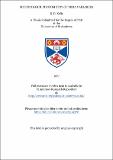Files in this item
Multicolour photometry of Mira variables
Item metadata
| dc.contributor.advisor | van Breda, I. G. | |
| dc.contributor.author | Kelly, B. D. | |
| dc.coverage.spatial | 139 p. | en_US |
| dc.date.accessioned | 2018-06-21T09:16:30Z | |
| dc.date.available | 2018-06-21T09:16:30Z | |
| dc.date.issued | 1977 | |
| dc.identifier.uri | https://hdl.handle.net/10023/14378 | |
| dc.description.abstract | In Part 1, a background to the project is provided by summarizing the general properties of Miras. A section is devoted to describing pulsating variables from a theoretical viewpoint, and this is followed by a discussion of past photometric work. Finally, a comparison is made between the theory and observations of Miras, which points out the well- known incompatibilities between the two approaches. Part 2 begins by underlining the desirability of observing Miras in UBVRI, and then goes on to describe the mechanical design of the St. Andrews ten colour, two photo multiplier, automated photometer. This photometer was designed as a general user instrument for the South African Astronomical Observatory, where the observing programme was carried out between May 1973 and October 1974. The photometric characteristics of Miras are then reconsidered, and the adopted ten colour photometric system, which adds five 200 Å wide filters to UBVRI, is described. The procedures used for obtaining the observations, and the reduction methods are summarized, along with the likely sources of error. This is followed by the analysis of the results, which consists mainly of a description of the properties of the various two-colour diagrams, particular emphasis being placed on those such as (V-R, R-l) and (V, R-I) which show unexpectedly narrow sequences. In addition, considerable attention is directed at the scatter in the (U-B, R-I) diagram, and also at the interesting R Aqr system. The data are then considered from the period-luminosity- colour viewpoint, enabling a discussion of absolute magnitudes and the value of the pulsation constant, as well as an investigation, of the possible harmonic relationships between Miras of differing periods. Finally, an attempt is made to place the Me Miras in the (M[sub]bol, log Te) diagram, and the conclusion is drawn that the discrepancies between theory and observation can probably be mostly attributed to the methods of interpretation of the latter. | en_US |
| dc.language.iso | en | en_US |
| dc.publisher | University of St Andrews | |
| dc.subject.lcc | QB835.M5K3 | |
| dc.subject.lcc | Variable stars | en |
| dc.title | Multicolour photometry of Mira variables | en_US |
| dc.type | Thesis | en_US |
| dc.contributor.sponsor | Science Research Council (Great Britain) | en_US |
| dc.type.qualificationlevel | Doctoral | en_US |
| dc.type.qualificationname | PhD Doctor of Philosophy | en_US |
| dc.publisher.institution | The University of St Andrews | en_US |
This item appears in the following Collection(s)
Items in the St Andrews Research Repository are protected by copyright, with all rights reserved, unless otherwise indicated.

